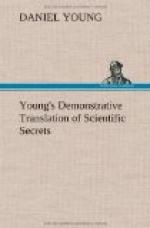Yellow No. 240, 12 parts; red oxide of iron, 1 part.
242. Deep blood red
Subsulphate of iron, calcined in a muffle until it becomes a beautiful capucine red, 1 part; flux No. 2, 3 parts; mix without melting.
243. Brown yellow ochre
Yellow ochre No. 244, 10 parts; sienna earth, 1 part; triturate without melting.
244. Deep yellow ochre—called yellow brown
Subsulphate of iron, 1 part; oxide of zinc, 1 part; flux No. 2, 5 parts; triturate without melting.
245. Pure purple
The purple powder of Cassius mixed while moist with flux No. 3, and sometimes a little chloride of silver previously melted with flux No. 3. If the purple, when prepared, does not melt sufficiently easy, some flux may be added when it is dry.
246. Deep violet
The purple of Cassius, in place of flux No. 3, flux No. 1 is mixed with it. Sometimes a little of blue No. 233 is added.
247. Flesh red
The sulphate of iron, put in a small crucible, and lightly calcined, produces a suitable red oxide. Those which have the desired tone are selected. All the flesh reds are made in this way, and vary only in the degree of heat which they receive.
248. Hair brown
Yellow ochre, No. 244, 15 parts; oxide of cobalt, 1 part; well triturated and calcined, in order to give the tone to it.
249. Liver brown
Oxide of iron made of a red brown, and mixed with three times its weight of flux No. 2. A tenth of sienna earth is added to it if it is not sufficiently deep.
250. White
The white enamel of commerce in cakes.
251. Yellowish grey
Yellow No. 252, 1 part; blue No. 233, 1 part; oxide of zinc, 2 or 3 parts; flux No. 2, 5 parts; sometimes a little black is added, according to the tone which the mixture produces. The proportions of the blue and yellow vary.
252. Yellow for browns & Greens
Antimonic acid, 2 parts; sulphate of iron 1 part; flux No. 1, 9 parts. This colour is melted and sometimes a little Naples Yellow is added if it is too soft, i.e., melts too easily.
253. BLUEISH grey for mixtures
Blue previously made by melting together three parts of flux No. 1, and one part of the mixture of oxide of cobalt, 8 parts; oxide of zinc, 1 part; sulphate of iron calcined at a forge heat, 1 part; flux No. 2, 3 parts; triturate and add a little manganese in order to render it more grey.
254. Grayish black for mixtures
Yellow ochre, No. 244, 15 parts; oxide of cobalt, 1 part; triturate and calcine in a crucible until it has the desired tone. A little oxide of manganese is added in order to make it blacker; sometimes a little more of oxide of cobalt.




